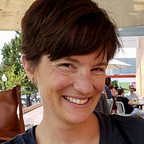An Abortion Doctor Goes To Work On Ash Wednesday
For God so loved the world that he gave his one and only Son, that whoever believes in him shall not perish but have eternal life. — John 3:16
A Wednesday morning in February
7 A.M.
At the gym before work I am taken off guard, as I am every year, when a man steps off a treadmill, or a woman turns away from the wall where she is stretching to face me. Their foreheads are smeared with ash. The marking always seems a bit crude, almost brutal — but perhaps this is intentional.
I feel both grateful and guilty to be here. I remind myself that I have earned this luxury: a quick, heart-pumping workout. For three years I went without exercise, and survived on barely any sleep, while I trained for the job I have now — a job that allows me this spare ninety minutes before work, while someone else watches my children, to release something from my body — energy, anxiety, some sadness. The worries of a mother, a wife, a doctor.
8:45 A.M.
As I pull into the parking lot, a cluster of men and women — more than usual, nearly a dozen — peer into my car window, their faces somber. They will be stationed here, day and night, for the next forty days. Among them is a young girl, maybe ten or eleven years old. Their signs display bloody fetuses, a cross, a slogan: Pray To End Abortion.
10 A.M.
A young woman, the hood of her red sweatshirt pulled over her head, the drawstring cinched so that it nearly covers her eyes, stares out at me from the deep, quiet place where she has waited for me to enter the room. There is no turning back now. She bites her lip as I read the consent form aloud. When I ask her what she’s thinking, she tells me she’s never done this before. “I don’t believe in it.”
“Are you sure of your decision?” I ask.
She shrugs; her eyes are now fixed on the wall behind me. “I got five kids,” she says.
She is twenty-five years old.
The procedure is quick and straightforward, one of many today. She clutches the sides of the bed, twisting her hips back and forth, trying to stay still as I’ve asked her to.
When it’s over she asks, “Has anyone ever taken it home after? Like, to do a funeral for it?”
“You’re not the first person to ask me that,” I say. “But we can’t allow you to leave with it.” Part of the consent form she has signed designates that the tissue will be disposed of as biomedical waste. “You can certainly see it, though. A lot of people want to see it.”
She tells me she wants to see it. I bring it back into the room in a little dish. It is an early pregnancy; nothing is recognizable, but she points to a small bit of pinkish white tissue and asks, “Is that the head?”
“No. It’s not. It’s a little bit torn apart. But this is everything.”
“This is everything,” she repeats, almost in a whisper.
Then she looks hard at the dish in my hand. She says, “I love you. And I’m sorry.”
How would our myths and our origin stories be different if they were written by women, if they told the stories of mothers and daughters? What sacrifices and acts of selflessness would be sanctified, and which ones would be punished?
